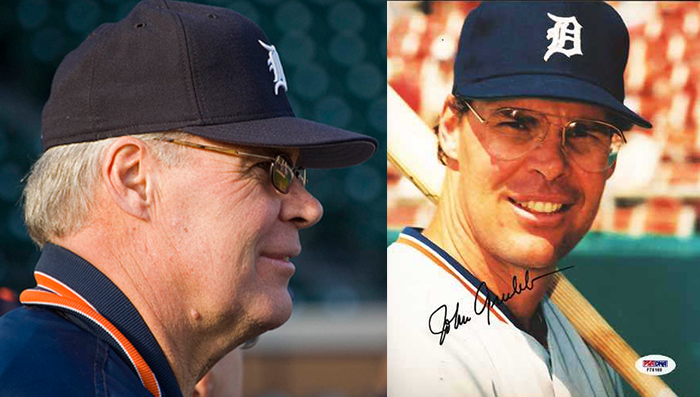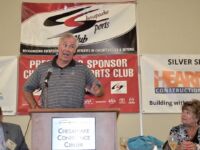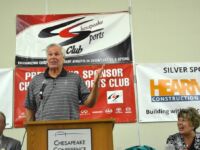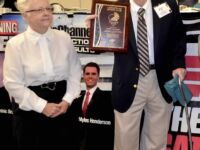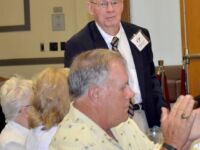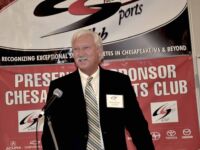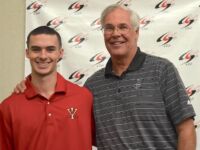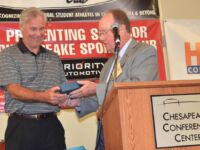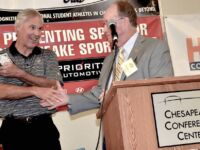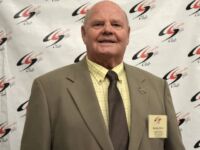Our August 8th speaker was Johnny Grubb was a Major League Baseball player for 15 years who won a World Series for the Tigers.
This article below was written by Mike McClary,
The 1984 Detroit Tigers were a team filled with larger-than-life personalities, from a media-savvy manager in Sparky Anderson to a confident and boisterous leader in Kirk Gibson. And while some of the bigger names on the Tigers’ roster captured much of the attention for clutch hits throughout that magical year, the team turned to a quiet gentleman from Virginia to deliver in a pivotal moment in Detroit’s quest for the American League pennant.
John Maywood “Johnny” Grubb, Jr. was born on August 4, 1948, in Richmond, Virginia, to John Grubb, Sr. and Geraldine Grubb. One of three children, and the only son, Grubb gravitated to sports and baseball in particular during his childhood. “There were not a whole lot of neighbors, so I’d pretty much just watch some of the Yankee games on television and then I got a real interest in baseball,” Grubb said.
As was the case with many other boys growing up in the 1950s, Grubb’s favorite player – and Yankee – was Mickey Mantle. After watching Game of the Week on television, Grubb would head outside and take some cuts, imitating the players he’d watched that afternoon. “I ended up learning how to hit both right- and left-handed just from watching them on television,” he said.
At Meadowbrook High School in Richmond, where his classmates included future professional golfers Lanny and Bobby Wadkins, Grubb excelled at basketball and football as well as baseball. After his sophomore season, he gave up football to focus on baseball, which, he acknowledged, was probably a smart decision. “I might have gotten hurt, as small as I was then,” Grubb said.
After graduation, he enrolled at Manatee Junior College – now Manatee Community College – in Bradenton, Florida, where he played two seasons under coach Bob Wynn. After his sophomore year, Grubb was drafted for the first of four times in a two-year span. In 1969, the Boston Red Sox drafted him in the third round of the amateur draft, but Grubb chose to remain at Manatee. Later that year, the Cincinnati Reds selected him in the first round with the 14th overall pick of the amateur draft’s secondary phase.
Rather than sign with the Reds, Grubb instead transferred to Florida State University in Tallahassee and starred on the 1970 squad that compiled a 49-9 record and finished as runner-up to the University of Southern California for the NCAA championship. Grubb led FSU in hitting with a .303 regular-season average. In the College World Series, he again led the Seminoles in hitting and was named to the All-Series team. Later he was named an honorable mention All-American.
The Atlanta Braves drafted Grubb in the third round of the 1970 amateur draft (secondary phase), but he opted not to sign. On January 13, 1971, the San Diego Padres selected him with the 24th pick of the first round in the secondary phase. With only two quarters remaining at FSU, he weighed his options and then signed with the Padres.
“I took pride in being a good outfielder, and thought I had a better-than-average arm,” Grubb said. “And though I was not a real burner as a baserunner, I felt like I had better-than-average speed. So I felt like I had the four tools that they wanted. Especially in the National League, they want you to be able to field, run, hit, and have a good arm. And, of course, like they always said, if you can hit, they’ll find a place to play you somewhere.”
Grubb’s professional career began in 1971 with the Class A Lodi Padres of the California League. The Padres promoted him the next season to the Double-A Alexandria (Louisiana) Aces of the Texas League. Hall of Famer Duke Snider managed the Aces, and the team’s pitching coach was former Dodgers – and Tigers – left-hander Johnny Podres.
By and large, Grubb spent most of his time in the outfield in the minors but he dabbled, at the club’s request, at third base:. “They were trying to get me to learn how to play a little bit of third. So I wasn’t sure if they were going to have me at third or the outfield. Then they had a guy that they signed as a bonus player, Dave Roberts. They played him at third, and then they ended up moving me back to the outfield, which was fine with me. I liked the outfield.”
Grubb’s fast track to the major leagues continued at the end of the 1972 season, when the Padres promoted the 24-year-old outfielder to the big club in September. On September 10, 1972, he made his major-league debut as the starting center fielder in a doubleheader against the Atlanta Braves. Grubb promptly collected his first major-league hit, a seventh-inning single to right off Ron Reed. In the nightcap, Grubb got two more hits and his first major-league –RBI. In seven games, Grubb batted .333 with a double and triple.
He spent the offseason playing for Obregón in the Mexican League to get more playing time and experience at the professional level. Grubb said the talent in the Mexican League was similar to that of Double-A or Triple-A clubs in the United States. His experience in Mexico apparently provided Grubb with the edge the Padres were looking for; he broke camp with the team in 1973 and his 16-year big league career was in second gear – and he’d never have to put it in reverse by returning to the minors.
In his first full major-league season, Grubb appeared in 113 games for a new manager, Don Zimmer, and played almost exclusively in center field, hitting .311 with eight home runs and 37 RBIs. He finished sixth in the National League Rookie of the Year Award voting, with the Giants’ Gary Matthews winning the award running away. (Grubb did, in fact, play some third base during his rookie season. He played four innings over two games at third but never had to make a play.)
Grubb saw even more playing time in 1974 – and he capitalized on it. Of all Padres who qualified for the National League batting title, he led in several offensive categories, including a .286 batting average, a .355 on-base percentage and a .758 on-base plus slugging (OPS) percentage. That year New York Mets manager Yogi Berra selected Grubb as an All-Star reserve — and the Padres’ only representative – for the game in Pittsburgh. In his only at-bat in the All-Star Game, Grubb popped out to shortstop on a pitch from Oakland hurler (and eventual Hall of Famer) Catfish Hunter in the seventh inning.
“I was real happy to be on an All-Star team,” Grubb said. “It was a little unusual that it was only my second year in the league. But I was just happy to be there.”
Grubb played two more seasons in San Diego, hitting .269 and .284, respectively. After the 1976 season, he was traded with catcher Fred Kendall and infielder Hector Torres to the Cleveland Indians for outfielder George Hendrick. Grubb said he was looking forward to playing for Indians manager Frank Robinson, who had tapped him as an everyday player in 1977. But a hand injury just 34 games into the season made Grubb’s first year in Cleveland one to forget.
“I did it on a checked swing,” he said. “I tried a checked swing on one of Gaylord [Perry]’s nasty pitches. Some people call it a spitter, but it could have been a forkball, I don’t know. But I tried to check my swing and I guess the knob of the bat came across my hamate bone. And it’s a strange way to do it, but it broke it off and I ended up having to go in” for surgery.
In 1978, Grubb played for his fourth manager in his five major-league seasons: Jeff Torborg, who replaced Robinson during Grubb’s injury-shortened the 1977 season. It turned out that 1978 was also the season in which he could fully immerse himself in studying the American League brand of baseball, and hitting in particular.
“As an athlete, you have to be able to adjust. And I didn’t know much about the American League, and the National League took pride in being real aggressive on the basepaths and playing for one run, not trying to go for the big inning all the time,” he said.
“In the American League, the first thing I noticed was that they kind of pitched a little backwards. In the National League, if they were behind in the count … if the pitcher was behind in the count, you could pretty much bet on a fastball,” Grubb said. “In the American League, you couldn’t count on that. They could throw you a changeup, a curveball with the bases loaded and two strikes on you. They just kind of pitched a little backwards because of the smaller ballparks. And actually, I thought the pitching was better in the American League because they weren’t as predictable. Like I said, you couldn’t count on a fastball in fastball situations. So it took a while to get used to that. But if you watch and study the pitchers, you start learning how they pitch guys in certain situations.”
Grubb also had to get used to a role he never played in the National League: that of the designated hitter. “That took a little bit of getting used to as well because you have an at-bat and then you go sit. So I had to find a way to keep myself ready,” he said. “And you could either go down in the bullpen area or go up in the clubhouse and swing the bat or go down wherever you could find a place to stay loose and try to keep yourself in the game instead of just sitting there waiting around for your next at-bat.
“So you just learn to try to find out what works for you and make sure you’re ready for your next at-bat. But I’m sure it prolonged my career because I played almost until I was 40,” he said. “And I don’t know if I’d have played that long had I been in the National League.”
With his contract expiring at the end of the 1978 season, Grubb sensed the Indians were not going to re-sign him and, as the trading deadline approached, expected a trade. On August 31, 1978, he was traded to the Texas Rangers for two players to be named later. (The two turned out to be pitcher Bobby Cuellar and minor-league outfielder Dave Rivera.)
When Grubb joined Billy Hunter’s Rangers for a weekend series against the Milwaukee Brewers, Texas was 65-65 and in third place in the American League West, just 4½ games behind the first-place Kansas City Royals. In his first game as a Ranger, on September 3, Grubb went 1-for-4 with a single off Ed Farmer. In 21 games with Texas to close out the ’78 season, he hit .394 with a homer and six RBIs in 33 at-bats. The Rangers finished the year in second place with an 87-75 record, five games behind the Royals.
Over the next four seasons, from 1979 to ’82, Grubb hit .272 for Texas and still saw most of his playing time in the outfield. In the spring of 1983, he could sense that a change was coming in Arlington. “I hadn’t had much playing time in spring training, so I knew something was going to happen,” he said. “Either they were going to just release me or make a trade. And I didn’t think they would just release me because I felt like I could still play.”
On March 24, he got the answer. “[Rangers manager] Doug Rader called me into his office and he told me that they had made a trade. He said, ‘Grubsteaks, you’re going to like where you’re going.’ I said, ‘Where’s that?’ And he said ‘Detroit.’ And, of course, I looked at him and kind of said ‘Yup. That would be a good team to go to.’ We knew they were strong and getting better each year and right on the verge of being a real, real good ballclub. So I was happy to go there.”
In his first season with the Tigers, 1983, Grubb, wearing number 30, played in 57 games, mostly in right field and as the designated hitter; he batted .254 with four home runs and 22 RBIs. That season the Tigers were in the hunt for the American League East lead most of the summer. In fact, Detroit flirted with first place as late as August 26, when the club was just one game behind the eventual World Series champion Orioles. The Tigers wound up finishing second with a 92-70 record, but the groundwork was set for 1984.
Though he was now 35, Grubb’s playing time increased in 1984, up to 86 games and 276 at-bats as an outfielder, DH, and – a more common occurrence – pinch-hitter. Now the seasoned veteran on a team featuring twentysomethings Alan Trammell, Lou Whitaker, and Lance Parrish, among others, Grubb settled into his role and enjoyed the ride. “It was fun to watch those guys play and every once in a while to jump in and do something myself,” he said.
“What I remember most about that year is that I never really felt like we were out of any ballgame,” Grubb said. “Any lead a team could get, we felt like we could have a big inning and jump right back in the game. And we had real good pitching, so if we had the lead, we had Willie [Hernandez] and [Aurelio] Lopez coming in to shut the door on them. The pitchers did their job, and the hitters did their job. And we just felt like we could win any game.” Grubb finished the ’84 season with a .267 average, eight home runs, and 17 RBIs, and set his sights on the American League Championship Series matchup with the Royals. After coasting to victory in Game One of the ALCS, the Tigers found themselves in a nail-biter in Game Two.
The Tigers jumped out to a 3-0 lead but the Royals chipped away to tie the game in the eighth inning. With one out in the top of the 11th, and with Ruppert Jones on first and Darrell Evans at second, Grubb faced Dan Quisenberry, who led the American League with 44 saves that season. The left-handed-hitting Grubb was 0-for-1 against Quisenberry during the regular season and had just two hits in 12 career at-bats against him. Grubb waited as the submariner and his batterymate, John Wathan, discussed their pitching strategy. “He got two strikes on me and Wathan went out to the mound. I was watching them when they were out there talking. I thought I could read their lips and I thought I saw them saying ‘fastball.’ And I thought, well, I can’t trust that, but I’m going to be ready for it.” Hitless in his previous three at-bats in the game, Grubb was looking to change his luck and power his team to a 2-0 series lead.
As Wathan got into his crouch, Grubb dug in. On the next pitch, he ripped a two-run double to right-center to put the Tigers up 5-3 in the game and leave them one win away from the World Series. “He threw a fastball, and I’m sure [Royals center fielder] Willie Wilson was cheating-in a little bit on me with two strikes. But I happened to get a hold of one and drove it over his head. So I’m glad I came through to help out. That was my turn, I guess, to do something to help the team.” The Tigers clinched the pennant two days later, defeating the Royals 1-0 in Game Three.
One could argue that for the Tigers to play the first game of the 1984 World Series in San Diego was perhaps more special for Alan Trammell and John Grubb than other members of the team. Trammell was raised in San Diego and it’s where Grubb’s career had begun 12 years earlier. “That was real neat to go back. When they did the introductions, I remember they gave me a nice ovation. I wasn’t sure really what they might do. You’re not sure if fans are going to turn on you or not. But they were really, really nice. And, of course, we had friends that still lived back there, and just going back where I started my career.”
Grubb made his first World Series appearance in Game Two, as the designated hitter, batting seventh. He singled to left off Padres starter Ed Whitson in the first inning. It was the fifth, and last, hit off Whitson in the inning before he was replaced by Andy Hawkins with two out. Grubb also played in Games , as designated hitter and a pinch-hitter, but went hitless in both games, though he was hit by a Hawkins pitch in the World Series-clinching Game Five.
The final three years of Grubb’s Tigers career were no different than his first two; he played sparingly in the outfield and was used primarily as Sparky Anderson’s DH. His finest statistical year in Detroit came in 1986. In 81 games, he hit .333 with 13 home runs and 51 RBIs.
Detroit returned to the postseason in Grubb’s final year, 1987. The Tigers fought the Toronto Blue Jays over the final 10 days of the season and clinched the AL East title on the last day. Though his regular-season numbers were the lowest in his 16 years – a .202 average, two home runs, and 13 RBIs – Grubb excelled in the ALCS against the Minnesota Twins. Appearing in four of the five games, he batted .571 on four hits in seven at-bats.
Grubb’s major-league career came to a close on October 12, 1987, in Game Five of the ALCS. He collected a hit in his final at-bat, a single to left field off his former Tigers teammate, Juan Berenguer, in the eighth inning. The Tigers lost the game, 9-5, and the series, four games to one. Four days later, the Tigers released the 38-year-old Grubb.
“Coming into that season, I was close to 40, so I knew it was getting right down to the end,” Grubb said. “And I knew Sparky probably saw me as not going to have a whole lot of playing time, a guy off the bench. So I knew it was a good chance it might be my last year, but I wouldn’t allow myself to think that way. And I just had a poor season, but ended up having a good playoff for us. But I wish I’d have had a better season for us. I just didn’t do that well that year.”
In 1,424 major-league games, Grubb collected 1,153 hits, with 99 home runs, and finished with a .278 career batting average.
Grubb returned in the fall of 1987 to his hometown of Richmond, where he settled with his wife, Linda. They had two sons, Chris and Corey, and four grandchildren. The year 2009, the 25th anniversary of his Tigers’ World Series victory, found him coaching the varsity baseball team at his alma mater, Meadowbrook High School. One of his former players, Cla Meredith, reached the majors with the Boston Red Sox in 2005, played for San Diego for three years, and in 2009 was traded to the Baltimore Orioles.
Although Johnny Grubb played for four major-league teams, there’s no question where his affection rested: with the Detroit Tigers. As recently as 2009, he was still active with the Tigers organization, participating in fantasy camps each winter in Lakeland, Florida.
“Early in the season in spring training,” Grubb said, “I remember vividly one statement Sparky made here in Detroit. He said, ‘Look, guys, if you go out there and give them your heart and soul, they’ll do the same thing. But if you dog it on them one time, they won’t ever forget it.’ And he was right. Those fans in Detroit – that was one of my best memories, and still is the way the fans treated me and the players. You could tell they were diehard fans. It wasn’t like that at the other places that I played. Detroit is a special town. They loved their sports and loved their Tigers.”

